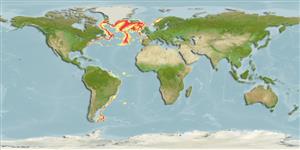Ολοκέφαλοι (χίμαιρες) (chimaeras) >
Chimaeriformes (Chimaeras) >
Chimaeridae (Shortnose chimaeras or ratfishes)
Etymology: Hydrolagus: hydro-, combining form of hydor (Gr.), water; lagos (Gr.), hare, i.e., “water rabbit,” probably referring to three pairs of tooth plates, which tend to protrude from the mouth like a rabbit’s incisors. (See ETYFish); affinis: Latin for related, referring to its similarity to Chimaera monstrosa. (See ETYFish).
Environment: milieu / climate zone / depth range / distribution range
Οικολογία
Θαλασσινό(ά) βαθύβιο(ς); εύρος βάθους 300 - 3000 m (Ref. 117245). Deep-water; 70°N - 58°S, 80°W - 41°E
Northeast Atlantic: Rockall Trough along Ireland, northern Bay of Biscay and off Portugal. Reported from Iceland (Ref. 12462). Southwest Atlantic: Uruguay (Ref. 58839). Northwest Atlantic: Newfoundland in Canada to Cape Cod in USA. Probably has a much wider distribution. Possibly occurring off the Cape in South Africa and off Mozambique (Ref. 11228).
Μέγεθος / Βάρος / Age
Maturity: Lm ? range ? - ? cm
Max length : 130 cm TL αρσενικό/απροσδιόριστο; (Ref. 4443); 125.0 cm TL (female)
Lacks a separate anal fin. Pectoral fin does not overlap pelvic fin. Short caudal filament. Dark brown in color (Ref. 6902).
Epibenthic (Ref. 58426). Found on continental slopes and down to deep-sea plains. Reported down up to 3000 m along the mid-Atlantic ridge (Ref. 83979, C.Cotton pers.comm. 03/10). Feeds on small fishes and invertebrates (Ref. 6680). Oviparous (Ref. 205). Eggs are encased in horny shells (Ref. 205). It is commercially used as fish meal and to produce high-quality machine oil from the liver (Ref. 117245).
Life cycle and mating behavior
Γεννητική Ωρίμανση | Αναπαραγωγή | Γεννοβολία | Αβγά | Γονιμότητα | Προνύμφες
Hardy, G.S. and M. Stehmann, 1990. A new deep-water ghost shark, Hydrolagus pallidus n.sp. (Holocephali, Chimaeridae), from the eastern North Atlantic, and redescription of Hydrolagus affinis (Brito Capello, 1867). Arch. Fisch. Wiss. 40(3):229-248. (Ref. 3330)
IUCN Red List Status (Ref. 130435)
Threat to humans
Harmless
Human uses
αλιεία: χωρίς ενδιαφέρον
Περισσότερες πληροφορίες
ΑναφορέςΥδατοκαλλιέργειεςΠροφίλ υδατοκαλλιέργειαςΣτελέχοιΓενετικήElectrophoresesΚληρονομικότηταΑσθένειεςΜεταποίησηNutrientsMass conversion
ΣυνεργάτεςΦωτογραφίεςStamps, Coins Misc.ΉχοιΣιγκουατέραΤαχύτηταΚολυμβητικός ΤύποςΕπιφάνεια βραγχίωνOtolithsΕγκέφαλοιΌραση
Εργαλεία
Special reports
Download XML
Διαδικτυακές πηγές
Estimates based on models
Preferred temperature (Ref.
123201): 3.3 - 4.3, mean 3.5 °C (based on 57 cells).
Phylogenetic diversity index (Ref.
82804): PD
50 = 0.5000 [Uniqueness, from 0.5 = low to 2.0 = high].
Bayesian length-weight: a=0.00282 (0.00118 - 0.00673), b=3.10 (2.89 - 3.31), in cm total length, based on LWR estimates for this (Sub)family-body shape (Ref.
93245).
Τροφικό Επίπεδο (Ref.
69278): 4.3 ±0.41 se; based on food items.
Ελαστικότητα (Ref.
120179): Χαμηλό, ελάχιστος χρόνος για διπλασιασμό πληθυσμού 4,5 - 14 έτη (Assuming Fec <100).
Fishing Vulnerability (Ref.
59153): Very high vulnerability (78 of 100).
Nutrients (Ref.
124155): Calcium = 8.44 [2.45, 28.17] mg/100g; Iron = 0.345 [0.115, 0.914] mg/100g; Protein = 16.1 [10.5, 19.1] %; Omega3 = 0.299 [0.107, 0.829] g/100g; Selenium = 23.6 [7.3, 77.0] μg/100g; VitaminA = 5.7 [1.2, 25.5] μg/100g; Zinc = 0.265 [0.133, 0.516] mg/100g (wet weight); based on
nutrient studies. 